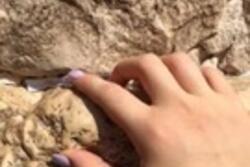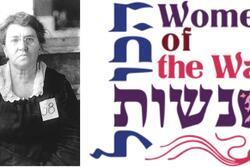The Wall Between My Identities
Lesley Sachs and Rachel Cohen Yeshurun, members of Women of the Wall, being detained by a police officer for wearing tallit at the Kotel. Via Wikipedia.
I visited Israel for the first time this past summer on a month-long trip with my camp. Jerusalem was the first stop. Because I knew of it as one of the holiest sites in the world, I was excited to visit the Western Wall and to connect to this historic part of Judaism. I expected to feel emotion and attachment to the Kotel. However, despite the burning midday sun, my first visit left me cold. I didn't connect with this place of reverence that I had heard so much about.
We hopped off the bus a few blocks away, and I scrambled to pull my knee-length skirt up over my athletic shorts. Walking there, I was certain that this visit would change my Judaism, or at least inspire it. We stood in line. And stood. And stood. My skirt was long, thick, and had started to itch. Finally, we got past security, had a group talk about our meeting spot, and were let loose onto a massive limestone plaza. The sun shone down, making everyone squint. The Orthodox men who prayed at this wall every day shuffled around us, their peyot swinging and massive black hats held high. I had some prior information about the Wall and the unequal treatment of women there, but that didn’t stop me from feeling perturbed when I stepped into the significantly smaller women's section.
Judaism and feminism are two critical parts of my identity, and they have almost always fit together. That day, I felt a rift open between the two. In order to take part in the Jewish ceremony of prayer and to insert slips of paper with prayers written on them into the cracks of the Wall, I would have to enter on the terms that the Orthodox impose on every visitor. I was surprised to learn that fights often break out between the more conservative men and more liberal women when women try to sneak Torahs into their section or when women’s prayers are heard over the separation because Hasidic men are not allowed to hear women sing. I felt like I was supposed to accept the injustice that occurred there.
While I found the Wall culturally and visually interesting, I left that day feeling dissatisfied and disappointed. I felt no sense of wonder, and I was left wrestling with the sexism I had seen. This is the first situation I faced where, in order to immerse myself in one part of my identity, I had to temporarily relinquish the other. Is it Jewish people's responsibility to have the Wall be important to them despite the way women are treated there?
As the trip continued, I didn’t reflect on it much; I had found so many other meaningful parts of Israel. At the end of the month, we circled back to Jerusalem where we had begun. Between the first and second visits to Jerusalem, I’d had a lot of amazing experiences that elevated my Jewish pride and religious identity. However, it didn’t change how I felt about the Western Wall.
Then, we met with Women of the Wall. They are an organization working to obtain social and legal recognition for women to have the right to pray, wear prayer shawls, and read Torah at the Western Wall. Hearing about their struggles and their perseverance was inspiring. These dedicated women devote their time and effort to being able to hold Torah services at the same Wall that I initially thought was irrelevant to my Jewish journey. The Women of the Wall’s refusal to follow the rules can elicit an aggressive response, but they are undeterred by this violence.
Looking back, I realize that the Wall did have meaning for me, but not in the way that I was expecting. I think I learned to appreciate the Wall in a different way, as a symbol of empowerment and feminism, and that gives it much more meaning to me. In the Women of the Wall's movement, I see two critical parts of my identity, Judaism and feminism, working together. I came to realize that, to me, the Wall wasn’t an object of reverence, but an object of feminist resistance. It made me feel hopeful that these threads of my identity, Judaism and feminism, can be tied together.
This piece was written as part of JWA’s Rising Voices Fellowship.








These threads can be tied together! Very well-said.
Fantastic! I always love reading about different experiences at the Western Wall-- they're all so interesting and unique. Thank you for sharing yours.
Such an interesting piece. It reminded me of my own first visit to the wall many decades ago , and elevates our complicated reactions into a thoughtful discussion. Sasha is my granddaughter and I am proud of her.
This is amazing sash Mazel Tov <3